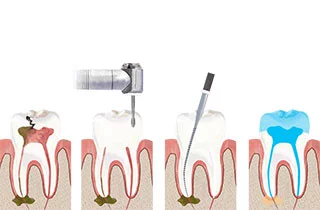Root canal treatment is a medical intervention to save a tooth. A specialist should execute the treatment, however, after the treatment; the patient’s tooth can serve well for a long time.
This article will answer the following questions about root canal treatment:

- What is a root canal treatment?
- How does tooth root inflammation develop?
- When is a root canal treatment necessary?
- Which are the root canal symptoms in case of an infection?
- How long does the treatment take?
- What is the process of the intervention?
- Advantages and disadvantages of root canal treatment
What is a root canal treatment?
A root canal treatment is necessary when the roots or the inside of a tooth are infected. During the treatment, the dentist mills out the infected root canal and fills out the void in it. After a treatment, the tooth isn’t alive anymore. This kind of treatment is the last opportunity to save a tooth so that the natural dental crown can still fulfill its function. In addition, in the case of teeth badly damaged by caries, this treatment can prevent bacteria from reaching the bone tissue.
How does tooth root inflammation develop?
There are several reasons for the development of a tooth that needs root canal treatment.
Such an instance happens when the blood vessels and nerves running through the tooth root are damaged and the tooth responds to this injury with inflammation or death. In a dead tooth, harmful bacteria multiply at the site of blood vessels and nerves. These bacteria also cause severe damage to the jaw bone over time.
Not only can damage the blood vessels and nerves but also a neglected, perforated tooth start the above processes if the inflammation spreads into the gums.
The third case is when a tooth dies unnoticed, during a long-lasting, large-scale filling, and later the inflammation can also be seen around the root on an X-ray.
When is a root canal treatment necessary?
The treatment is necessary when bacteria damage the teeth and penetrate the root canals as a consequence of dental caries.
The main goal of the treatment is to avoid removing the damaged tooth as much as possible and to save the crown of the tooth that needs treatment from decay. In the past, such teeth were usually removed, often without replacement, so these teeth were forever missing from patients ’dentures. In this case, other irreversible processes began: since chewing ceased in this area, the jawbone usually began to decay and atrophy.
Which are the root canal symptoms in case of an infection?
One of the root canal symptoms is a rather strong toothache: the patient may feel a strong pounding as well as pressure pain.
It is important to know that although the pain ends and the tooth is not alive any longer, in the case of an infection root canal symptoms can still spread out onto other, still healthy tissues.In many cases, it may happen that a dead tooth does not cause pain or other complaints. This is why regular dental check-ups are extremely important, since a dentist can easily spot these problems during a routine dental check-up.
How long does the treatment take?
It may last from one to seven dental sessions, depending on how crooked the root canals are.
What is the process of the intervention?
In the framework of this treatment, practically everything is removed from the inside of the tooth that might get infected. This means the surrounding tissue, the nerves and the pulp.
Within the framework of this intervention first, the tooth is benumbed. Second, the dentist drills out the tooth and completely cleanses it with a dental medical drill. This step requires great care to prevent bacteria from reaching the root canals. As the last step, the inside of the tooth is filled with filling material such as cement, synthetic material or with another type of material.
Advantages and disadvantages of root canal treatment
One definite advantage of this treatment is that the patient does not lose this tooth. Even though the tooth is basically not alive anymore, it has been saved, so that it can fulfill its function of chewing and biting.
Tooth rescue is not only functional but also aesthetically and materially beneficial. Quality tooth replacement is not a cheap procedure and nothing can look more like an original tooth than the original tooth itself.
Some patients would rather have the tooth extracted instead of the root canal treatment. However, one should take into consideration that the replacement of a tooth takes a lot more time than a simple root canal treatment.
However, this treatment might have possible disadvantages. For example, the dental crown could possibly break during drilling. Another risk is that the root canals are not prepared for the filling thoroughly enough. This way bacteria can potentially remain in the root canals. But an experienced dentist will not make these mistakes.
Root canal teeth usually start to darken over time, so their colour can differ from the color of the healthy teeth surrounding them. Of course, aesthetic dentistry also has solutions for this, and this problem can also be treated by coloring or placing a crown.
If you take proper care of your root canal tooth, it can serve you for a lifetime. You should know that these teeth require the same care as their healthy counterparts and are even more fragile in general. With proper care, attention, and constant medical control, these problems can be prevented.


